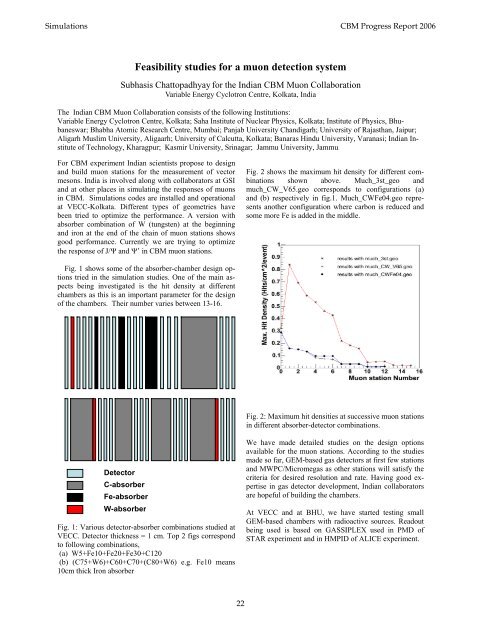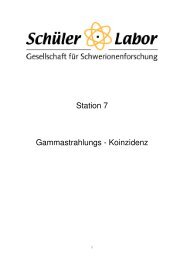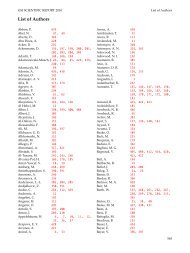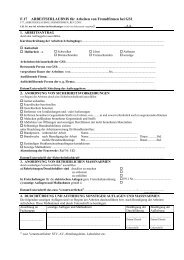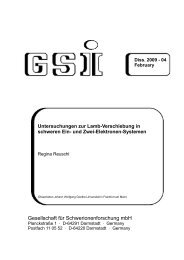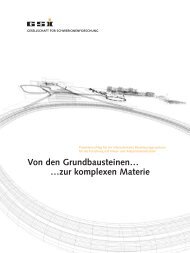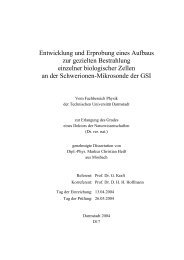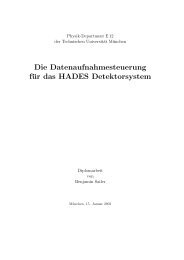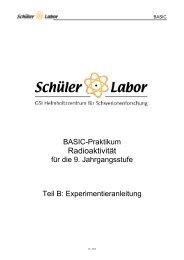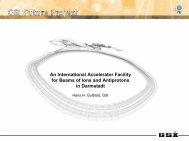CBM Progress Report 2006 - GSI
CBM Progress Report 2006 - GSI
CBM Progress Report 2006 - GSI
You also want an ePaper? Increase the reach of your titles
YUMPU automatically turns print PDFs into web optimized ePapers that Google loves.
Simulations <strong>CBM</strong> <strong>Progress</strong> <strong>Report</strong> <strong>2006</strong><br />
Feasibility studies for a muon detection system<br />
Subhasis Chattopadhyay for the Indian <strong>CBM</strong> Muon Collaboration<br />
Variable Energy Cyclotron Centre, Kolkata, India<br />
The Indian <strong>CBM</strong> Muon Collaboration consists of the following Institutions:<br />
Variable Energy Cyclotron Centre, Kolkata; Saha Institute of Nuclear Physics, Kolkata; Institute of Physics, Bhubaneswar;<br />
Bhabha Atomic Research Centre, Mumbai; Panjab University Chandigarh; University of Rajasthan, Jaipur;<br />
Aligarh Muslim University, Aligaarh; University of Calcutta, Kolkata; Banaras Hindu University, Varanasi; Indian Institute<br />
of Technology, Kharagpur; Kasmir University, Srinagar; Jammu University, Jammu<br />
For <strong>CBM</strong> experiment Indian scientists propose to design<br />
and build muon stations for the measurement of vector<br />
mesons. India is involved along with collaborators at <strong>GSI</strong><br />
and at other places in simulating the responses of muons<br />
in <strong>CBM</strong>. Simulations codes are installed and operational<br />
at VECC-Kolkata. Different types of geometries have<br />
been tried to optimize the performance. A version with<br />
absorber combination of W (tungsten) at the beginning<br />
and iron at the end of the chain of muon stations shows<br />
good performance. Currently we are trying to optimize<br />
the response of J/Ψ and Ψ’ in <strong>CBM</strong> muon stations.<br />
Fig. 1 shows some of the absorber-chamber design options<br />
tried in the simulation studies. One of the main aspects<br />
being investigated is the hit density at different<br />
chambers as this is an important parameter for the design<br />
of the chambers. Their number varies between 13-16.<br />
Detector<br />
C-absorber<br />
Fe-absorber<br />
W-absorber<br />
Fig. 1: Various detector-absorber combinations studied at<br />
VECC. Detector thickness = 1 cm. Top 2 figs correspond<br />
to following combinations,<br />
(a) W5+Fe10+Fe20+Fe30+C120<br />
(b) (C75+W6)+C60+C70+(C80+W6) e.g. Fe10 means<br />
10cm thick Iron absorber<br />
22<br />
Fig. 2 shows the maximum hit density for different combinations<br />
shown above. Much_3st_geo and<br />
much_CW_V65.geo corresponds to configurations (a)<br />
and (b) respectively in fig.1. Much_CWFe04.geo represents<br />
another configuration where carbon is reduced and<br />
some more Fe is added in the middle.<br />
Fig. 2: Maximum hit densities at successive muon stations<br />
in different absorber-detector combinations.<br />
We have made detailed studies on the design options<br />
available for the muon stations. According to the studies<br />
made so far, GEM-based gas detectors at first few stations<br />
and MWPC/Micromegas as other stations will satisfy the<br />
criteria for desired resolution and rate. Having good expertise<br />
in gas detector development, Indian collaborators<br />
are hopeful of building the chambers.<br />
At VECC and at BHU, we have started testing small<br />
GEM-based chambers with radioactive sources. Readout<br />
being used is based on GASSIPLEX used in PMD of<br />
STAR experiment and in HMPID of ALICE experiment.


